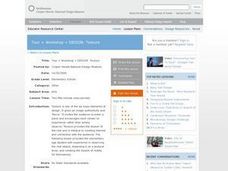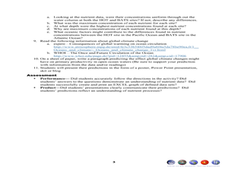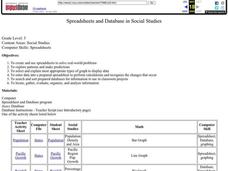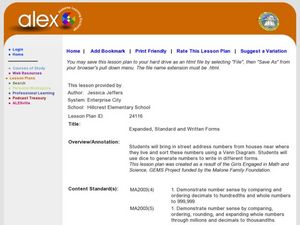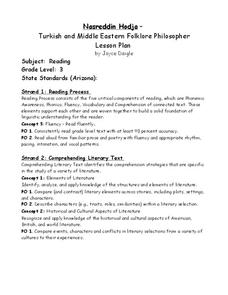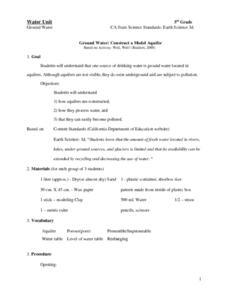Curated OER
Changing Places
This lesson involves live ladybugs. Students view two containers of water and take the temperature of each. They construct a graph on chart paper to compare the two containers. Students speculate which water sample the ladybugs will like...
Curated OER
Design and Texture
Students experience how texture is one of the six basic elements of design. It gives an image authenticity and 'flavor'. It invites the audience to enter a piece and encourages each viewer to experience rather than simply observe.
Curated OER
Bats and Hot Dogs
Students identify patterns and relationships from data that is collected and solve variables. In this investigative lesson students study ocean productivity, the nitrogen cycle and phytoplankton then answer questions.
Curated OER
Spreadsheets and Database in Social Studies
Fifth graders create/use spreadsheets to solve real-world problems, explore patterns and make predictions, select/explain most appropriate types of graph to display data, and enter data into a prepared spreadsheet to perform calculations.
Curated OER
Introduction to Adverbs
Students categorize a list of words into various categories of their choosing. They notice patterns in the lists and discuss -ly words and adverbs. They practice adding adverbs to sentences.
Curated OER
Grammar Lesson Plan
Students in an adult ESL class practice everyday english patterns. They identify how to use "want to", "need to" and "have to". They practice as a whole class and review concepts as necessary.
Curated OER
Forms of Poetry
Pupils identify distinguishing features of poetry. They identify and use literary terminology including symbol, theme, simile, and alliteration. They recognize the effects of language.
Orange County Department of Education
Pepita Talks Twice
Third graders read Pepita Talks Twice and define the character traits of respect and responsibility. They write their examples of the characters traits on a character trait doll. Students recognize the character traits of respect and...
Curated OER
"Weather" or Not?
Students complete a three week unit about weather and how it affects our behavior. They read and discuss various books related to weather, conduct an experiment about the tilt of the earth, plan a field trip based on temperature,...
Curated OER
Expanded, Standard and Written Forms
Students explore expanded, standard, and written forms of numbers. In this number sense lesson, students examine the various ways of writing numbers as they complete a Venn diagram activity.
Curated OER
Messy Cookies
Fourth graders explain the idea of a missing factor in an equation. They recognize, represent and solve mathematical situations using patterns and symbols.
Curated OER
Shapes Are Everywhere
Third graders explore pattern blocks noticing their similarities and differences and share their observations with others. They classify shapes by discussing sides and angles and combine pieces to make new shapes.
Curated OER
What are Rocks and Minerals? How can they help us?
Sixth graders investigate the difference between rocks and minerals. They name the three kinds of rocks (sedimentary, igneous, and metamorphic) and know the differences between them.
Curated OER
It's Waltz Time!
Students, after hearing and viewing a video of the waltz scene from the musical, "Cinderella," by Mary Rodgers, "physicalize" a three beat rhythm with accompaniment video and discuss and evaluate triple meter. They master a song in 3/4...
Curated OER
Night Hike
Students explore Upham Woods at night and investigate about the special adaptations of nocturnal animals. They identify three nocturnal animals and how they are adapted to the night. Students explain what night vision is and how it works.
Curated OER
Exploring the Properties of Rectangular Prisms.
Students define properties of rectangular prisms. In this geometry instructional activity, students identify the relationship between two and three dimensional objects. They use Cabri technology to graph their figures.
Curated OER
Exploring Properties of Rectangular Prisms
Learners explore the properties of rectangular prisms. In this geometry instructional activity, students identify properties of two and three dimensional shapes. They use Cabri technology to create polygons and solve problems.
Curated OER
Guess My Rule (Function Tables)
Seventh graders recognize and solve functions. To reinforce the solving of word problems, 7th graders play a guessing game where they try to identify the functions used. They complete worksheets and draw graphs to match the problem in...
Curated OER
I Know What You Did this Summer
Students discuss the characteristics of a quality relationship and determine how such a relationship is maintained. After reading a scenario of a relationship, students take one character at a time and place themselves in the character's...
Pennsylvania Department of Education
Adding and Subtracting Rational Numbers to Solve Problems
High schoolers explore the concept of probability. In this probability instructional activity, students use area to determine probability. High schoolers use charts and spinners to help determine the probability of events such as...
Curated OER
Nasreddin Hodja - Turkish and Middle Eastern Folklore Philosopher
Third graders read a readers theater written by Nasreddin Hodja. In this Nasreddin Hodja lesson plan, 3rd graders learn about the philosopher and participate in one of his reader's theaters.
Curated OER
But We Need More, Where Will It Come From?
Young scholars write a persuasive letter and create a poster about pollution and conservation. In this pollution and conservation lesson plan, students learn how humans are the number 1 cause of pollution.
Curated OER
Grandfather Tang's Story
Young scholars recognize, describe, and perform transformations (rotation/turn, reflection/flip, and translation/slide) on two dimensional shapes.
Curated OER
Ground Water: Construct a Model Aquifer
Students recognize that one source of drinking water is ground water located in aquifers. They create a model of an aquifer and summarize their experience in a report.



